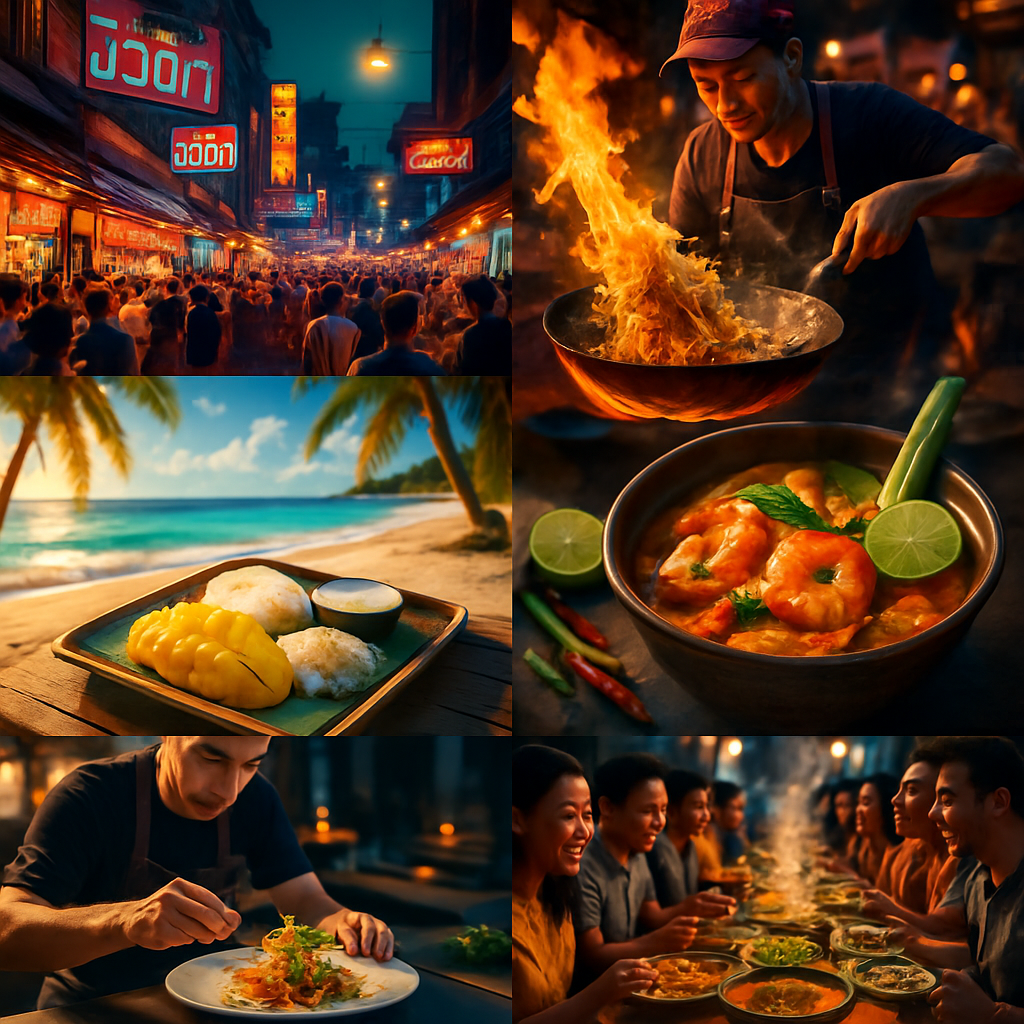Thailand has just been crowned the world’s best country for food, and the result tastes exactly as delightful as it sounds. In Condé Nast Traveller’s Readers’ Choice Awards 2025, the Land of Smiles snagged the top spot with a near-perfect score of 98.33 out of 100 — a culinary coronation that celebrates everything from sizzling roadside woks to sky-high tasting menus.
A flavour-packed victory lap
The win wasn’t a surprise to the millions who’ve navigated Bangkok’s night markets, hunted for the perfect bowl of soup in Chiang Mai, or surrendered to mango sticky rice on a sun-soaked beach. Voters praised Thailand’s bold, balanced flavours, its unbeatable street food culture, and a fine-dining scene that now rubs shoulders with the world’s best. CNN even noted that seven Bangkok restaurants made the cut among the world’s top 35 — proof that Thai cuisine thrives both at the humble stall and on the Michelin stage.
“It’s not just about the taste; it’s the experience. The warmth of the people, the bustling night markets, the aromas: it all comes together,” one reader told the magazine — and few travel-first love stories begin with a bland plate.
Street stalls, market chaos and culinary theatre
Picture Banthat Thong Road at dusk: sizzling woks, glints of oil, bundles of herbs piled into steaming bowls. From Pad Thai tossed over open flames to Tom Yum Goong that sings with lemongrass and lime, Thai food is an orchestra where sweet, sour, salty and spicy perform a perfectly timed crescendo. Green curry glows with coconut cream and chilies; mango sticky rice delivers that sublime sticky-sweet ending you didn’t know you needed.
But don’t pigeonhole Thailand as “just street food.” The nation’s culinary range stretches from humble noodle carts to avant-garde tasting menus that deconstruct familiar flavours into brilliant new forms. That contrast — street-food immediacy versus refined culinary craft — is a large part of what made Thailand irresistible to readers around the world.
How the rest of the world stacked up
Italy finished a very respectable second with 96.92%, celebrated for its pizza, pasta and the rich regional traditions of Emilia-Romagna. Japan edged into third on 96.77% thanks to its razor-sharp technique and delicate balance in sushi, tempura and kaiseki, and a Tokyo dining scene that still holds the highest number of Michelin-starred restaurants globally.
Following closely were Vietnam and Spain — Vietnam (96.67%) praised for its fresh, herb-forward dishes like pho and rice paper rolls, and Spain (95.91%) buoyed by tapas culture and culinary hubs like San Sebastián.
- 6. New Zealand — 95.79%: Native Māori techniques meet contemporary flair.
- 7. Sri Lanka — 95.56%: Coconut-rich curries, hoppers and fiery spice blends.
- 8. Greece — 95.42%: Olive oil, seafood and sun-drenched plates by the sea.
- 9. South Africa — 94.76%: Braai culture, bold flavours and fusion ingenuity.
- 10. Peru & The Maldives (tie) — 94.55%: Ceviche’s bright acidity and luxe island seafood.
Why Thailand rose to the top
Beyond the undeniably good food, Thailand’s win reflects a holistic dining culture. Meals are social events; markets are theatres; ingredients are local, seasonal and fearless. Whether you’re slurping noodles at a warung on a rainy night or sampling a molecular reinterpretation of som tam at a chic restaurant, the country invites you to taste, learn and repeat.
Tourists and food lovers alike are flocking not just for the dishes, but for the stories behind them — grandmother’s recipes, coastal fish markets, street chefs who’ve perfected their craft over decades. The result is an edible tapestry that’s as complex as it is welcoming.
Pack your appetite
If you’ve been waiting for an excuse to book a flight, consider this your sign. From Bangkok’s neon-lit lanes and Phuket’s seafood shacks to Chiang Mai’s mountain kitchens and Isan’s fiery grills, Thailand offers a culinary adventure at every turn. Bring stretchy pants, an adventurous palate and an appreciation for the people who make every bite memorable.
In an era where travellers rank experiences above possessions, Thailand’s victory is a delicious reminder: great food doesn’t just fill your stomach — it makes you fall in love with a place. Bon appétit, or as the locals say, gin khao reu yang? — Have you eaten yet?


















Thailand winning sounds right to me but is it just tourism hype? I’ve eaten amazing Thai food at home and abroad and it still felt special, yet I wonder if awards like this are just bandwagoning.
Totally a bandwagon sometimes, but try Pad Thai from a market stall in Bangkok and tell me it’s not different; there’s an electricity you can’t replicate in a fancy restaurant.
There’s a sociocultural dimension here: street food is embedded in daily life, not merely a commodity, and that authenticity often sways popular opinion more than curated tasting menus.
I don’t disagree about the market vibe, I just worry that popularity will price out locals and change the very thing people are praising.
That’s the sad cycle — tourists love it, money moves in, and then the soul of the market gets sanitized for Instagram.
Tourism gentrifies food scenes worldwide; awards amplify that risk and often benefit big players rather than street vendors.
As someone who grows chilies, I’m thrilled but skeptical — Thai food uses incredible fresh produce, yet most tourists eat the same three dishes.
True, but part of the magic is accessibility; even simple dishes are layered and respectful of ingredients, which is a win for growers.
Layered or overcomplicated? Sometimes street food feels slapped together and hyped because it’s exotic, not because it’s superior.
I want visitors to look beyond pad thai and mango sticky rice and ask about regional ingredients and seasons.
I’m happy Thailand topped the list, but can we stop ranking cultures like they’re cereal brands? Culinary value isn’t a scorecard.
Rankings are fun and get people to travel and try new things; besides, scores help highlight amazing chefs and habitats that deserve attention.
Attention is fine, but the nuance gets lost. What’s celebrated is often a tourist-friendly narrative rather than lived culinary practice.
Nuance matters, but without lists many lesser-known places never get discovered — both sides are true.
Italy second? Ridiculous — Italian food is centuries of regional genius, not just trending comfort.
Italy being second doesn’t erase its heritage, Luca; maybe readers are just craving bold flavors and street-level accessibility that Thailand offers.
Different evaluation metrics: Italy excels in terroir and slow traditions, while Thailand captivates with vibrant street culture and bold spices.
Fair, but I worry about younger people losing respect for the craftful restraint that defines so much of Italian cuisine.
Mango sticky rice is the best dessert ever, why didn’t my school cafeteria have that? I want to go to Thailand now!
Bring that enthusiasm, but also be ready for spicy surprises; not everything is sweet and friendly like mango sticky rice.
I can handle spice if I get mango sticky rice after, deal.
As a Thai person, this is nice to see but also complicated; tourists love our food, yet many locals can’t afford trendy restaurants.
Exactly, and some chefs open fine-dining spots that cater to foreigners instead of training locals, which feels off to me.
There’s a balance — recognition can fund culinary education, but policy and community-led tourism must protect access for locals.
I think these lists are just marketing for airlines and resorts; cuisine can’t be separated from colonial histories or economic power.
Sure, but food tourism can also redistribute income to small vendors if managed well; intent and implementation matter.
Implementation rarely follows intent though; look at places where locals are pushed out of their neighborhoods.
I’ve watched neighborhoods change over decades; sometimes the money helps, sometimes it erases memory — both happen.
From an anthropological perspective, Thailand’s win reflects global shifts toward valuing experiential, communal consumption over luxury exclusivity.
Agreed, and there’s also a culinary diplomacy angle: cuisine shapes soft power and national narratives in subtle but potent ways.
Yes, and scholars should study how such awards influence domestic food policies and labor practices, not only tourism flows.
I love Thai food but I’m worried about food safety after hearing horror stories about tourists getting sick from street stalls.
Food safety is real, but risk can be lowered by choosing busy stalls with turnover and using common sense; fear shouldn’t stop exploration.
Good point, I’ll look for busy places and ask locals where they eat — thanks for the tip.
Also, many locals eat those same stalls daily with no issue; it’s often a matter of stomach acclimatization.
Why are the Maldives tied at ten for food? Islands with resorts shout luxury but not necessarily authentic cuisine.
Island cuisine can be refined and unique; ceviche and fresh seafood deserve recognition even if it’s served in resorts.
Vietnam at fourth is well deserved, but it’s interesting how readers reward bright, herb-forward profiles — maybe a palate trend.
Palates do trend, but I hope this encourages people to explore regional diversity within countries, not just headline dishes.
As a chef, I’m proud but aware of the pressure this creates; chefs will be asked to perform culture for cameras more than diners.
That’s a real concern; performative dishes can undermine genuine culinary evolution and exploit tradition.
Exactly, which is why mentorship and community-rooted practices must come first when the spotlight grows.
I’ve traveled Southeast Asia since the seventies; the food was humble then and still is, but the context changed when money arrived.
Nostalgia is powerful, but change isn’t inherently bad; it can preserve some things and create new, interesting fusions.
I resent lists that treat countries like checkboxes. Culture isn’t a competition, it’s complex and messy and can’t be ranked.
I agree with the sentiment, but lists also make people curious; they spark travel and conversations we wouldn’t otherwise have.
Quick note: if you visit Thailand, try local markets at dawn — best produce and honest prices, avoid tourist traps.
Dawn markets are heavenly, plus you meet the people who actually live with the food culture rather than selling to it.
Spain and Peru high on the list shows how tapas and ceviche traveled the world; I’m glad diverse formats get applause.
Cultural exchange is great, but we must credit originators and avoid flattening distinct foodways into global fads.
Ranking food is subjective; my takeaway is that travel tastes are shifting toward bold, street-rooted flavors, and that’s exciting.
As long as ‘bold’ doesn’t mean ‘unsafe’ or exploitative, I’m on board — balance is key.
I cried eating mango sticky rice in Phuket once, true story. Food can be emotional and that’s why lists feel personal.
Emotional eating is real — food connects memory, place, and people. That’s harder to quantify than a percentage.
We should analyze the methodology behind these Readers’ Choice polls; sample bias, language, and access influence outcomes heavily.
Absolutely; reader-driven results reflect a particular demographic and platform reach, not an objective culinary truth.
One more thing: sustainable farming in Thailand is underrated and could be a focal point if tourism pushes demand for responsibly sourced ingredients.
Sustainability must scale with popularity; otherwise, we risk degrading the very ecosystems that make the food special.
As a dietitian, I love Thai food’s balance of herbs, vegetables, and lean proteins, but portion sizes at tourist spots can be excessive.
Portion inflation is a symptom of commodification; smaller, authentic servings often taste better and waste less.
I worry awards make single narratives the ‘official’ story; let’s not forget local, minority communities and their versions of cuisine.
Yes — spotlight should be shared and not just concentrate wealth and recognition in already privileged hubs.
Japan at third is deserved too; contrast matters — delicate techniques versus bold street flavors shows gastronomy’s range.
Contrast enriches global dining culture and inspires cross-pollination; I welcome that creativity.
If this gets more people cooking at home and valuing food traditions, I’m all for it; otherwise it’s just clickbait and plated photos.
Cooking at home would be a fantastic outcome; maybe these lists can inspire culinary curiosity beyond tourism.
Final thought: I will go try a street stall next trip but with caution, and I’ll buy from locals, not the touristized places.
That mindset helps local economies directly and often leads to the most authentic and sustainable experiences.
Thanks, I’ll plan carefully and support small vendors — hoping to taste something that changes me.